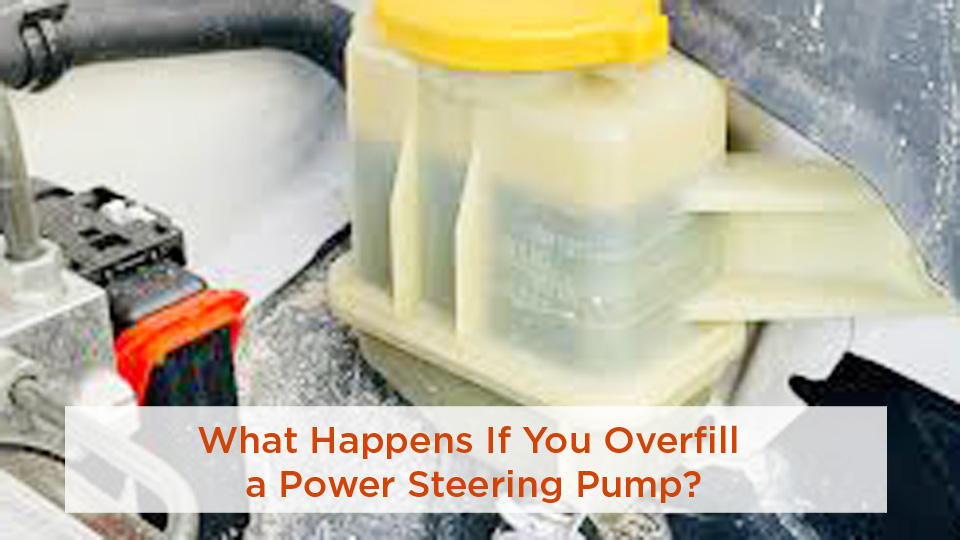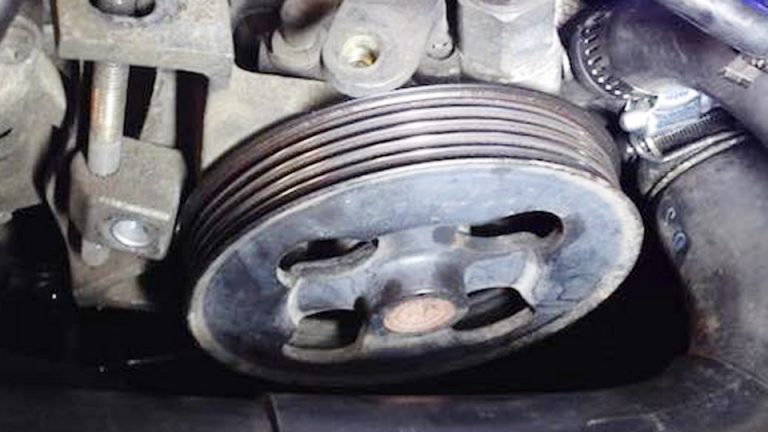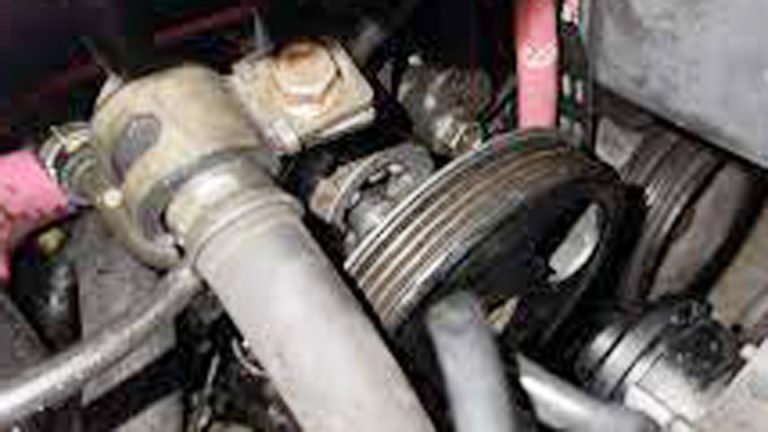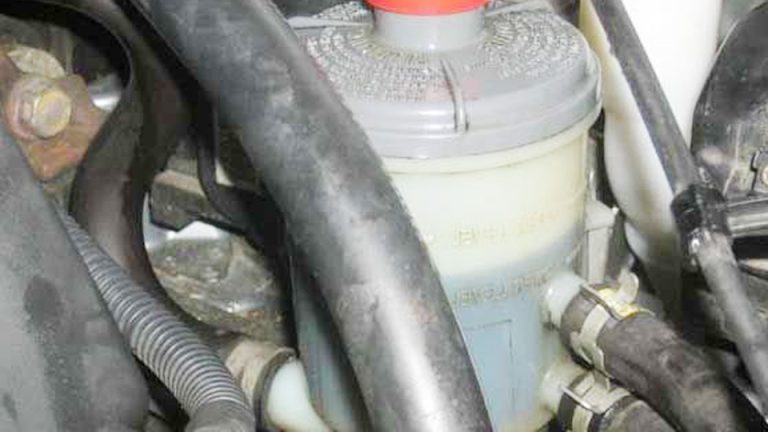You’d be surprised how often drivers run into steering problems that could’ve been avoided with a little extra care. One mistake I see all the time is overfilling the power steering reservoir. What Happens If You Overfill a Power Steering Pump? Well, it’s not just about a little spill on the driveway—too much fluid can create foam, put extra pressure on seals, and lead to steering that feels anything but smooth.
I’ve had cars come into my garage with this exact issue, and fixing it usually costs more than the driver expected. That’s why it’s important to understand how this simple part works and how to keep it in check.

Image by subaruoutback
Power Steering Pump: The Unsung Hero of Smooth Turns
What Exactly Is a Power Steering Pump and How Does It Work?
At its core, the power steering pump—often just called the PS pump—is a belt-driven hydraulic pump bolted right onto your engine block. It pressurizes power steering fluid (that reddish or clear stuff in the reservoir) and sends it through high-pressure hoses to the steering gear or rack. When you turn the wheel, valves in the system direct that pressurized fluid to one side or the other, giving you that light, responsive feel without breaking a sweat.
I’ve replaced hundreds of these over the years, from the compact setups in a Honda Civic to the beefy units in a Chevy Silverado. They all do the same job: convert engine power into steering assist. Without it, you’d be muscling the wheel like it’s 1950, and that’s no fun in modern traffic. The pump’s got a rotor inside that spins to create pressure—typically 1,000 to 1,500 PSI—and a relief valve to prevent over-pressurization. It’s simple engineering, but get it wrong, and it bites back.
Why Does the Power Steering Pump Matter for Your Daily Drive?
Safety first, always. A failing or overfilled pump can lead to stiff steering at low speeds, where you need it most, or even complete loss of control at highway speeds. Performance-wise, it affects handling—your truck might wander, or your sedan could feel vague in corners. And don’t get me started on cost: Ignoring issues leads to stripped racks or burst hoses, turning a $150 pump swap into a $1,000 bill.
From a reliability standpoint, these pumps are workhorses, but they’re exposed to heat, contaminants, and vibration. Fuel efficiency? A dragging pump from low fluid or air bubbles chews extra gas by putting load on the engine. In the US market, where we log serious miles, keeping this system tip-top saves headaches and wallet hits. I’ve had customers roll in after cross-country hauls, cursing a seized pump that could’ve been prevented with basic checks.
What Happens If You Overfill a Power Steering Pump? The Real Consequences
The Immediate Fallout: Leaks, Foam, and a Messy Reservoir
Overfilling might seem harmless—hell, I’ve done it myself in a pinch—but here’s the deal: That extra fluid has nowhere to go when the system pressurizes. It foams up like a shaken beer, introducing air bubbles that cavitate the pump. Suddenly, you’re hearing that high-pitched whine louder than before, and steering gets jerky.
In my shop days, a buddy overfilled his Jeep Wrangler’s system while prepping for off-roading. By the time he hit the trail, fluid was spraying from the reservoir cap like a geyser. We traced it to excess pressure blowing seals. Clean-up? A nightmare—fluid everywhere, eating paint if you’re not quick.
Long-Term Damage: Worn Vanes, Seals, and a Shorter Pump Life
Those bubbles? They erode the pump’s internal vanes and wear out seals faster than normal driving. Over time, you get leaks at the shaft or fittings, low pressure, and eventual failure. A pump rated for 100,000 miles might crap out at 50,000 if you’re chronically overfilling.
I’ve seen it in fleet trucks—guys topping off without checking levels properly. One Ford Transit van came in with a shredded pump after just 30,000 miles; autopsy showed foam-induced wear. Cost the owner $400 in parts alone, plus downtime.
Safety Risks and Roadside Nightmares
Worse than the mess is what happens mid-drive. Overfilled systems can cause erratic assist—too much one way, none the other—leading to overcorrections. Add wet roads, and it’s a recipe for trouble. I’ve towed more than one panicked driver whose pump grenaded on I-95, fluid dumping onto hot exhaust for that acrid smoke show.
Bottom line: Overfill by even a half-quart, and you’re courting cavitation, leaks, and failure. Stick to the dipstick marks; it’s your bible.
Signs Your Power Steering Pump Is on Its Last Legs
Groaning Noises and That Telltale Whine
The classic symptom? A whine or groan that ramps up with steering lock. It’s the pump starving for fluid or struggling against air. In my experience with GM trucks, this hits around 80,000 miles if fluid’s never changed.
One time, a customer swore his Subaru was haunted—whining like a banshee on turns. Turned out to be a clogged filter in the reservoir, but it mimicked pump failure. Always listen close; that sound’s your early warning.
Stiff Steering and Fluid Leaks Under the Hood
If the wheel fights you, especially cold, the pump’s likely toast. Check for red puddles under the front bumper—leaks from worn seals are common. I’ve chased drips on everything from Toyotas to Dodges; they love hiding near the alternator bracket.
Dashboard Warnings and Erratic Handling
Modern rides with EPS hybrids might throw codes, but hydraulic setups just feel off—vibration through the wheel or pulling to one side. A lady brought in her Nissan Altima last year; it was wandering like drunk on the highway. Pump pressure was down 30%; we caught it before a rack swap.
Spot these signs early, and you’re golden. Ignore ’em, and you’re funding my coffee fund.
When to Replace Your Power Steering Pump: Don’t Wait for the Whine
Mileage Milestones and Trigger Events
Most pumps last 75,000 to 150,000 miles, depending on the ride. But replace if you hear noise, see leaks, or after major front-end work. Overheating from towing? That’s a killer—I’ve pulled scorched units from Rams after summer hauls.
In the US, where rust belt winters chew hoses, swap proactively at 100,000 if you’re in Michigan or Ohio. Fluid turning black? Time’s up.
Cost of Delay vs Timely Swap
Procrastinate, and a $200 pump becomes $800 with rack damage. I once quoted a full system on a Honda Odyssey because the owner “didn’t want to bother” with the whine. Lesson learned: Address at first symptom.
OEM vs Aftermarket Power Steering Pumps: Breaking Down Your Options
The OEM Case: Factory-Fresh Reliability
OEM pumps from brands like ACDelco for GM or Mopar for Chrysler are engineered matches—perfect flow rates, quiet operation. Pros: Seamless fit, warranty-backed (often 12 months/12,000 miles), and they preserve resale value. Cons: Pricey—$150-$300 at dealers like AutoZone for a common fit.
I’ve installed countless Motorcraft units on Fords; they hum along for years. Downside? Lead times in backordered models, like during the chip shortage.
Aftermarket All-Stars: Value Without the Compromise
Aftermarket shines here—brands like Gates, Cardone, or TRW offer remanufactured pumps tested to OEM specs. Pros: Half the cost ($80-$150), wider availability at O’Reilly or Advance Auto, and often lifetime warranties. Cons: Quality varies; skip no-names to avoid early failures.
In my garage tinkering, a Cardone reman on a Chevy Malibu outlasted the original by 20,000 miles. US-specific: For imports, Denso aftermarkets rule for Toyotas.
| Feature | OEM (e.g., Delphi for GM) | Aftermarket (e.g., Cardone Reman) |
|---|---|---|
| Price Range | $150-$300 | $80-$150 |
| Warranty | 12 mo/12k miles | Lifetime (limited) |
| Fit/Compatibility | Exact match | 95%+ coverage for US models |
| Noise/Performance | Ultra-quiet, OEM feel | Near-OEM; test for whine |
| Availability | Dealer/parts stores | Immediate at chains |
| Best For | Warranty-conscious owners | Budget DIYers |
Pros and Cons: Weighing Reliability Against Your Wallet
OEM pros: Bulletproof longevity, no compatibility headaches. Cons: Sticker shock. Aftermarket pros: Affordable entry to quality fixes. Cons: Remans might need break-in. My pick? Aftermarket for daily drivers, OEM for trucks.
Vehicle compatibility’s key—check RockAuto for your VIN. A mismatched pump on a Subaru Forester? Recipe for leaks.
How to Replace a Power Steering Pump: My Step-by-Step Garage Guide
Tools You’ll Need and Safety First
Grab a 3/8″ ratchet set, flare-nut wrenches (to avoid rounding fittings), a fluid catch pan, and turkey baster for reservoir siphon. Safety: Disconnect battery, chock wheels, and wear gloves—fluid’s nasty on skin. I’ve skipped chocks once; car rolled, nearly took my toe.
For US trucks like the F-150, add a pulley puller—$20 at Harbor Freight.
Step-by-Step Removal: From Reservoir to Rack
- Prep the System: Engine off, cold. Siphon reservoir fluid into a pan—save the good stuff if clean.
- Loosen the Belt: Release tensioner; slip belt off pulley. On serpentine setups, mark routing.
- Disconnect Hoses: Use flare wrenches on high-pressure line—expect a gush. Plug lines with bolts to minimize spill. Low-pressure hose unclamps easy.
- Unbolt the Pump: Four bolts usually—13mm on most Fords. Wiggle free; pulley might stick.
Anecdote: On a rusty ’98 Tacoma, bolts snapped—drilled ’em out with cobalt bits. Patience pays.
Installation: Bleeding Air and Breaking It In
- Mount New Pump: Torque bolts to spec (25 ft-lbs typical). Reattach hoses—hand-tight, then quarter-turn.
- Replace Pulley if Needed: Press on with tool; align perfectly.
- Refill and Bleed: Fill reservoir, crank engine—no steering yet. Turn wheel lock-to-lock 20 times, top off. Repeat till no bubbles. Pro tip: Jack front wheels off ground for easier bleeding.
Common mistake? Forgetting to flush old fluid—contaminants kill new pumps fast. I’ve resurrected “bad” installs by rerunning this.
Whole job: 1-2 hours DIY. Cost: $100-250 total.
Maintenance Tips to Make Your Power Steering Pump Bulletproof
Fluid Checks and Changes: The 30,000-Mile Ritual
Inspect levels monthly—engine running, AC on for accurate read. Change fluid every 30k-50k miles; use ATF for most domestics, CHF for Euros. I’ve mixed types once—gummy mess in a VW Passat.
Brands: Valvoline MaxLife for universals, $10/quart at Walmart.
Hose and Belt Inspections: Catch Issues Early
Crack-check hoses yearly; replace rubber at 100k. Belts? Tension and cracks. A slipped belt starved a customer’s Escalade pump—$300 lesson.
Heat Management and Driving Habits
Avoid max-lock turns parked—overheats fluid. Towing? Cooler lines help. In hot Texas summers, I’ve added coolers to Silverados; dropped temps 20 degrees.
Common Mistakes When Handling Power Steering Fluid and Pumps
Overfilling and Under-Bleeding Blunders
We’ve covered overfill—don’t. Under-bleeding leaves air, whining ensues. I botched a bleed on my own ’05 Mustang once; drove like a tank till I re-did it.
Wrong Fluid or Skipping Flushes
ATF in a synthetic system? Seals swell. Always flush with compatible fluid—two quarts usually.
Customer story: Guy poured motor oil in his Prius hybrid assist—seized the motor. $1,200 fix.
Ignoring Contaminants and Pulley Alignment
Dirt in fluid grinds vanes. Filter screens clog—clean ’em. Misaligned pulley? Bearing wear accelerates.
Spotting Genuine Power Steering Parts: Don’t Get Burned by Fakes
In the US, counterfeits flood eBay—hologram labels missing, packaging off. Genuine ACDelco? Box has QR codes; scan for authenticity. Aftermarket? Stick to Cardone’s Select line—stamped casings.
Tip: Buy from NAPA or RockAuto; returns easy. I’ve returned suspect Amazon pumps—felt light, failed in weeks.
Price red flags: $50 for a $150 part? Run. Check fitment charts religiously.
Conclusion: Steer Clear of Power Steering Pitfalls with Smart Choices
Wrapping this up, the power steering pump is your ride’s quiet guardian—treat it right, and it’ll reward you with effortless miles. From dodging the overfill disaster (stick to the marks, folks) to picking a solid reman over a sketchy cheapie, it’s all about proactive smarts. Weigh OEM for peace of mind or aftermarket for value, but always verify fit and flush like your drive depends on it—because it does.
Regular checks and changes extend life; ignore ’em, and you’re in for leaks and labor. For smarter buys, cross-shop prices at three stores and read reviews from real installs.
After any fluid work, take a 10-mile test drive with varied turns—feel for smoothness before calling it done. Your wheel will thank you, and so will your wallet. Hit the garage armed with this, and drive on confidently.
FAQ: Quick Answers to Power Steering Pump Head-Scratchers
How Often Should I Change Power Steering Fluid?
Every 30,000 to 50,000 miles, or sooner if it darkens or smells burnt. In dusty areas like the Southwest, bump it to 25k—keeps contaminants at bay and pumps happy.
Can I Use Transmission Fluid in My Power Steering System?
Depends on the vehicle—most domestics say yes to Dexron ATF, but check your manual. Euros like BMWs need specific synthetics. Wrong type? Seals fail fast; I’ve seen it gum up a Mercedes in months.
What’s the Average Cost to Replace a Power Steering Pump?
DIY: $100-$250 parts and tools. Shop: $400-$800 labor included. Trucks run higher due to access; sedans are quicker.
Why Is My Power Steering Whining Even After Adding Fluid?
Likely air in the system—bleed it properly, lock-to-lock with engine running. Or a loose belt; tension it. If persists, pump internals might be shot.
Is a Power Steering Pump Rebuildable, or Always Replace?
Remans are pre-rebuilt and cheap—go that route. DIY rebuild kits exist for gearheads, but it’s fiddly; vanes and seals need precision. I’ve rebuilt a few vintage Mopars, but for moderns, new’s easier.



